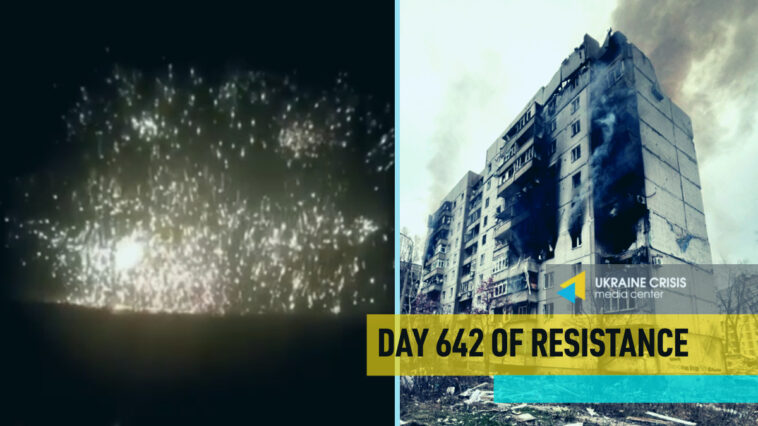Russian forces make advances around Avdiyivka, the Institute for the Study of War says. Ancient Scythian artefacts returned to Ukraine after nine years of court battles.
Russian forces make advances around Avdiyivka, ISW says
Russian forces made confirmed advances northwest and southeast of Avdiyivka on November 26, the Institute for the Study of War (ISW) said in a report released on Sunday.
Geolocated footage published on November 26 shows that Russian forces marginally advanced northwest of Krasnohorivka (7km northwest of Avdiyivka) and in the eastern part of the industrial zone on Avdiyivka’s southeastern outskirts.
Geolocated video footage on November 26 shows Russian armored vehicles attacking Ukrainian positions in the northern part of the industrial area on Avdiyivka’s southeastern outskirts.
Russian milbloggers overwhelmingly claimed that Russian forces captured the entire industrial area near the Yasynuvata-2 railway station on November 26, though ISW has not observed visual confirmation of these claims yet.
Russia has decreased the use of kamikaze drones and artillery because of bad weather, spokesperson for the joint press center of Ukraine’s defense forces in the Tavriyskyi direction, Colonel Oleksandr Shtupun told the Ukrainian public broadcaster Suspilne. Heavy fighting rages near Avdiyivka’s industrial zone. Ukrainian troops maintain control of the Avdiyivka coke plant, he said.
“We observe a decrease in the use of unmanned aircraft. Due to poor weather conditions the enemy is using almost six times fewer drones that drop munitions and FPV drones. But they carry out intense air strikes. Russian forces also continue ground attacks. They attack in groups of 10-20 people. In the past day, they lost three tanks and more than 500 troops, of which 80 per cent were in Donetsk region, in the Avdiyivka direction,” Shtupun said.
Russia has also decreased the use of artillery due to bad weather. In the past day, in the Tavriyskyi direction, they made 600 attacks as opposed to around 900 a day earlier.
Intense fighting rages near the Avdiyivka coke plant and in the industrial area east of Avdiyivka, Shtupun said. Ukrainian troops maintain control of the factory. “The enemy is on the offensive in six directions. Very intense fighting rages across all the lines. The enemy has not achieved success,” he said.
According to Shtupun, Russian forces rely on infantry troops and aircraft. They attack in groups of 10-20 people. They previously used groups of not more than 10 people, he said.
The last six weeks have likely seen some of the highest Russian casualty rates of the war so far. The heavy losses have largely been caused by Russia’s offensive against Avdiyivka, UK defence intelligence said in an update on Monday.
Throughout November 2023, Russian casualties, as reported by the Ukrainian General Staff, are running at a daily average of 931 per day.
Previously, the deadliest reported month for Russia was March 2023 with an average of 776 losses per day, at the height of Russia’s assault on Bakhmut.
Although Defence Intelligence cannot verify the methodology, taken as a total including both killed and wounded, the figures are plausible.
Ancient Scythian artefacts returned to Ukraine
Ancient Scythian artefacts, known as the Scythian gold, have been returned to Ukraine. In a statement on Monday, the National Museum of the History of Ukraine in Kyiv said: “After almost 10 years of court hearings, artefacts from four Crimean museums that were presented at the exhibition ‘Crimea — Gold and Secrets of the Black Sea’ in Amsterdam have returned to Ukraine.”
The collection would be kept in the museum until the de-occupation of Crimea. Amsterdam’s Allard Pierson Museum has returned 565 items including ancient sculptures, Scythian and Sarmatian jewelry and Chinese lacquer boxes made two thousand years ago.
The Allard Pierson Museum said the objects, which were “independently checked and carefully packed in accordance with museum rules” last month, arrived in Kyiv on Sunday. Ukraine’s Customs Service released a video showing what it said was a lorry with the artefacts weighing 2,694kg entering the Kyiv-Pechersk Lavra and heading to be identified at the museum’s facilities.
The director of the history museum in Kyiv, Fedir Androshchuk, urged for “unprecedented security” of the collection and additional funds to support the museum’s work during the war.
In 2016, the District Court of Amsterdam ruled that the artefacts that were on display in the Netherlands must be returned to Ukraine. Some 565 artefacts, mostly from Crimean museums, were on loan to the Allard Pierson Museum for the exhibition “Crimea — Gold and Secrets of the Black Sea”.
It went on display in February 2014 and ended when Russia seized and annexed the peninsula. According to the Ukrainian legislation, the collection is part of Ukraine’s cultural heritage. The Ministry of Culture was supposed to decide where to take the items.
In August 2017, the museums in occupied Crimea appealed against the ruling.
In July 2019, a Dutch appeals court postponed the ruling. The court ruled in 2021 that the treasures belonged to Ukraine. In June 2023, the Dutch Supreme Court agreed with that decision, ruling that the items should be returned to Ukraine.
The Unchanging Weaponization of Hunger by the Kremlin. Ukraine in Flames #538
This year Ukraine commemorates the 90th anniversary of the Holodomor genocide of 1932-33. We remember this sad date today in the realities of the new struggle for the survival of the Ukrainian nation. 90 years after the Holodomor-genocide was committed on the territory of Ukraine, Russia is committing a new genocide – war. Watch Ukraine in flames #538 to find out about famine and how it was used by Russia in historical retrospect and the current attempts of the terrorist country to use the issue of food and provoking famine to achieve its imperialistic goals again.
Guests:
- Hennadii Yefimenko, Historian, Senior Researcher of the Department of History of Ukraine of the 20-30s of the 20th century
- Andrii Ivanets, Leading Researcher of the Holodomor Research Institute of the National Holodomor Genocide Museum
- Maksym Mayorov, Employee of the Center for Strategic Communications and Information Security




